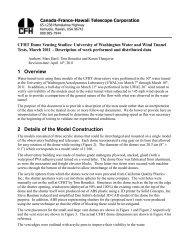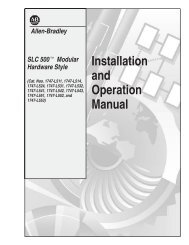Documentation [PDF] - Canada France Hawaii Telescope ...
Documentation [PDF] - Canada France Hawaii Telescope ...
Documentation [PDF] - Canada France Hawaii Telescope ...
You also want an ePaper? Increase the reach of your titles
YUMPU automatically turns print PDFs into web optimized ePapers that Google loves.
Filter u g r i z<br />
- ApCorr - ApCorr - ApCorr - ApCorr - ApCorr<br />
D1 0.003 0.002 0.007 0.005 0.006 0.002 0.001 0.001 0.005 0.001<br />
D2 0.002 0.001 0.002 0.002 0.004 0.002 0.001 0.002 0.004 0.002<br />
D3 0.006 0.008 0.014 0.001 0.004 0.001 0.001 0.002 0.000 0.001<br />
D4 0.014 0.007 0.033 0.003 0.015 0.007 0.002 0.000 0.008 0.001<br />
Table 1: Zero-point difference for Deep field exposures before and after L99 observations, with and without the<br />
application of an aperture correction (left and right columns for each filter, respectively). In all cases except D3-u ∗<br />
the application of the aperture correction reduces the difference.<br />
obstacle.<br />
3.7.5 SNLS standard star catalogue<br />
The complete CFHTLS-T0007 release (both Deep and Wide) are photometrically calibrated using the<br />
SuperNova Legacy Survey (SNLS) tertiary standards catalogs. These catalogs have been produced and<br />
release as products of the SuperNova Legacy Survey. They have been made available at CDS in the<br />
catalog interface Vizier 18 . The detailled description of the production of the catalogs is described in<br />
(Regnault et al., 2009).<br />
A summary of the description is reproduced here.<br />
This is the photometric calibration of the SuperNova Legacy Survey (SNLS) three year<br />
dataset. The SNLS corresponds to the DEEP component of the larger <strong>Canada</strong>-<strong>France</strong>-<br />
<strong>Hawaii</strong> <strong>Telescope</strong> Legacy Survey (CFHTLS). The SNLS repeatedly monitors four one square<br />
degree fields (labeled D[1-4]) with the MegaCam wide-field imager, in the g, r, i and z bands.<br />
u-band observations of the same fields are also available, although not formally part of the<br />
SNLS dataset.<br />
(...)<br />
The SNLS 3 year calibration relies on the ((Landolt, 1992)) standard star catalog. Landolt<br />
fields are observed during each photometric night along with the SNLS fields. Zeropoints<br />
are derived from these observations. Stable and isolated stars are detected on the<br />
SNLS fields and selected as "tertiary standards". The calibrated magnitudes of each tertiary<br />
standard obtained under photometric conditions are combined to produce a calibration<br />
catalog for each SNLS field.<br />
(...)<br />
To interpret the tertiary standard magnitudes as physical fluxes, we need a primary standard,<br />
i.e. a star with known MegaCam magnitudes and whose spectral energy distribution<br />
has been measured absolutely. The SNLS uses BD+17 4708 whose SED has been measured<br />
in Bohlin & Gilliland, 2004, Cat. J/AJ/128/3053 using the HST STIS and NICMOS spectrographs.<br />
BD+17 4708 has not been directly observed by SNLS, however, its MegaCam<br />
magnitudes were inferred from its known Landolt magnitudes ((Regnault et al., 2009), table<br />
7).<br />
(...)<br />
18 http://cdsarc.u-strasbg.fr/viz-bin/Cat?J/A%2bA/506/999<br />
18


![Documentation [PDF] - Canada France Hawaii Telescope ...](https://img.yumpu.com/26965302/30/500x640/documentation-pdf-canada-france-hawaii-telescope-.jpg)









